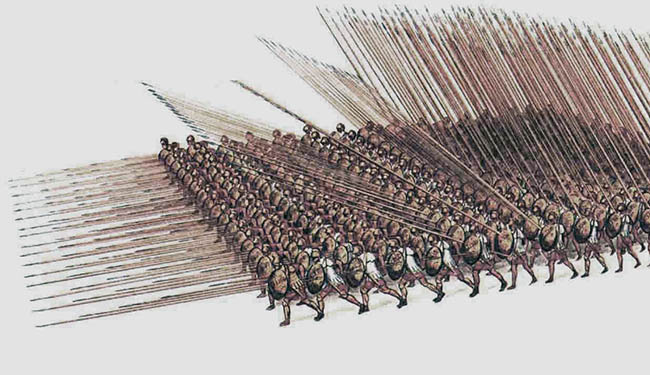Philip II of Macedon (reign 359-336 BC) ascended the throne of Macedon in his late twenties. Philip II had found himself regent, because the king Amintas IV was only an infant. As regent, Philip II promptly overthrew his infant nephew, the king, and crowned himself as Macedonian king in 359 BC. In his early twenties, Philip II had been a political hostage. During the Theban hegemony over a Greece he lived in Thebes. As political hostages Philip generally lived a good life. In Thebes they simply kept Philip II in order to executed him if hostilities commenced between the Theban government and Macedonians. Philip II in Thebes lived a relative good life. He was well-integrated into the politics and military. Philip II also learned Greek politics and military strategy.
In Thebes Philip II studied military skills under the renowned general Epaminondas. Epaminondas reforms were the basis for the phalanx. Phalanx were professional soldiers thereby allowing them to execute complex maneuvers well beyond the reach of most other armies. Phalanx soldiers fought in a close rectangular formation, often eight men deep, with a leader at the head of each column. Secondary leader of phalanx were in the middle, so that the back rows of phalanx could move off to the sides if more frontage was needed. Philip II had learned to be a general and he learned how to use phalanx in battle. Each phalanx carried as his primary weapon a double-pointed pike over 6 m (18 ft) in length named sarissa.
When he finally become king of Macedon, Philip II promptly pacified all the Greek tribes to his north, seized gold and silver mines. Then he conquer the city of Amphipolis, Philip II began to build new cities and large standing armies.
During the siege Methoni city in Central Macedonia 354 BC, Philip II was injured in his eye. It was later removed surgically. Despite the arrival of two Athenian fleets, he conquer the city.
After he conquer Methoni Philip II turn his army to the south. In 349 BC he began to systematically conquer all the Greek cities. After a great victory against Athens and its allies in 338 BC in the Battle of Chaerenoea, Philip found himself in control of all Greece (except Sparta). Philip promptly went to work at securing his power in Greece, building garrisons at Corinth, Thebes, and Chalcis. In 338 BC, Philip created the confederation of Greek cities called Corinthian Legue. Ostensibly an alliance of free city-states, Philip had become a king of almost all Greek cities. The independent city-state, the polis, had ceased to exist, but Philip wasn’t finished.



The Persian Wars still festered in the Greek memory, and the Spartan invasion of Persia in 379 BC showed Philip that it was possible to defeat the mightiest empire known to humanity. So in 337, Philip announced the Corinthian League would attack Persia as revenge for the wars. In 336 BC he stood poised to prosecute his mighty invasion of the Persian Empire, but an assassin’s sword ended his great campaign. It should’ve ended the brief Macedonian control of Greece, but Philip’s twenty-one year old son Alexander stepped to Macedon throne and became the new conqueror.
